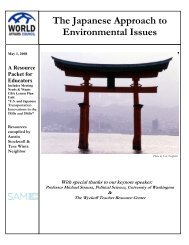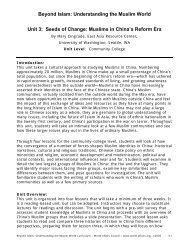The Question(s) of Tibet - World Affairs Council
The Question(s) of Tibet - World Affairs Council
The Question(s) of Tibet - World Affairs Council
You also want an ePaper? Increase the reach of your titles
YUMPU automatically turns print PDFs into web optimized ePapers that Google loves.
ENVIRONMENTAL ISSUES<br />
remote parts <strong>of</strong> the <strong>Tibet</strong>an borderlands, collecting plants, taking photographs and collating<br />
maps. He described his trips in several articles in the National Geographic journal. After reading<br />
his articles, I was inspired to revisit places he described in Sichuan and Yunnan such as Muli,<br />
Yading, Deqin and Gongga Shan. This blog describes my travels and compares Rock's pictures<br />
with ones I have taken in the same places.<br />
HUNT INSTITUTE FOR BOTANICAL DOCUMENTATION: JOSEPH FRANCIS ROCK<br />
http://huntbot.andrew.cmu.edu/HIBD/Departments/Archives/Archives‐HR/Rock.shtml<br />
This website contains biographical information about Joseph Rock and photographs.<br />
WATER/RIVER ISSUES<br />
MOUNTAINS OF CONCRETE: DAM BUILDING IN THE HIMALAYAS (2008)<br />
http://www.internationalrivers.org/files/IR_Himalayas_rev.pdf<br />
Recent years have seen a renewed push for building dams in<br />
the Himalayas. Massive plans are underway in Pakistan,<br />
India, Nepal and Bhutan6 to build several hundred dams in<br />
the region, with over 150,000 Megawatts (MW) <strong>of</strong> additional<br />
capacity proposed in the next 20 years in the four countries. If<br />
all the planned capacity expansion materializes, the<br />
Himalayan region could possibly have the highest<br />
concentration <strong>of</strong> dams in the world. This dam building<br />
activity will fundamentally transform the landscape, ecology<br />
and economy <strong>of</strong> the region and will have far‐reaching<br />
impacts all the way down to the river deltas. Submergence <strong>of</strong><br />
lands, homes, fields and forests on a large scale will displace<br />
hundreds <strong>of</strong> thousands <strong>of</strong> people. Damming and diversion <strong>of</strong><br />
Why <strong>Tibet</strong> matters so much.<br />
<strong>The</strong> <strong>Tibet</strong>an plateau is the water-tower <strong>of</strong> all Asia. <strong>The</strong><br />
Yellow River, the Yangtse, the Mekong, the Salween,<br />
the Iriwaddy, the Brahmaputra, the Ganga and<br />
Yamuna, the Indus complex -- all these rivers rise in<br />
environmental <strong>Tibet</strong>, and the cleanness and fertility and<br />
glacial cool <strong>of</strong> the plateau are critical to the health <strong>of</strong><br />
these nine alluvia that sustain the lives <strong>of</strong> over three<br />
billion people, in the most populated swathe <strong>of</strong> peoples<br />
on earth, from the Chinese, through the Vietnamese,<br />
Cambodians, Laotians, Thai, Burmese, Bangladeshis,<br />
Indians, up to the Pakistanis. <strong>The</strong> de-forestation,<br />
dessication, pollution, and overheating due to<br />
colonization <strong>of</strong> the headwater regions <strong>of</strong> all these rivers<br />
will be a global disaster <strong>of</strong> epic proportions.<br />
http://www.huffingtonpost.com/robert-thurman/whytibet-matters-so-much_b_465496.html<br />
rivers will severely disrupt the downstream flows, impacting agriculture and fisheries and<br />
threatening livelihoods <strong>of</strong> entire populations. Degradation <strong>of</strong> the natural surroundings and a<br />
massive influx <strong>of</strong> migrant workers will have grave implications for the culture and identity <strong>of</strong><br />
local people, who are <strong>of</strong>ten distinct ethnic groups small in numbers….<br />
A NEW ERA FOR TIBET’S RIVERS (1/17/11)<br />
http://www.chinadialogue.net/article/show/single/en/4055<br />
<strong>The</strong> rushing waters <strong>of</strong> the Yarlung Zangbo, the last <strong>of</strong> China’s great rivers to remain<br />
undammed, will soon be history. On November 12 last year, the builders <strong>of</strong> the Zangmu<br />
Hydropower Station announced the successful damming <strong>of</strong> the river – the first public<br />
announcement on a matter that, until now, has been kept under wraps. <strong>The</strong> Zangmu<br />
hydroelectric power station is being built on the middle reaches <strong>of</strong> the Yarlung Zangbo (known<br />
as the Brahmaputra when it reaches India) between the counties <strong>of</strong> Sangri and Gyaca. Around<br />
7.9 billion yuan (US$1.2 billion) is being invested in the project, located in a V‐shaped valley<br />
3,200 metres above sea level. At 510 megawatts, the plant is much smaller than China’s 18,000‐<br />
megawatt Three Gorges Dam, but still equivalent to the entire existing hydropower‐generating<br />
capacity <strong>of</strong> <strong>Tibet</strong>.<br />
<strong>World</strong> <strong>Affairs</strong> <strong>Council</strong> Teacher Resource Packet – <strong>The</strong> <strong>Question</strong>(s) <strong>of</strong> <strong>Tibet</strong> February 28, 2011<br />
16











